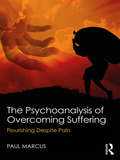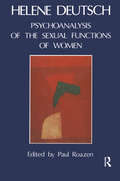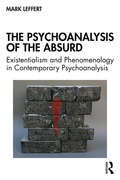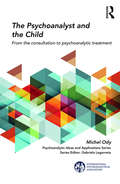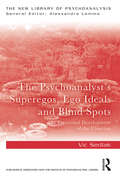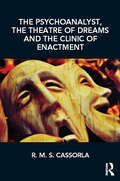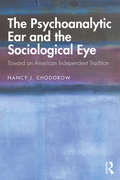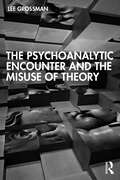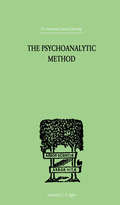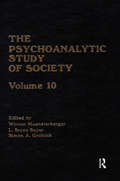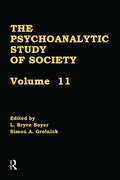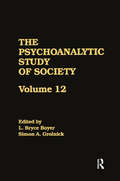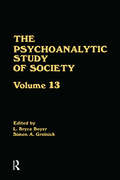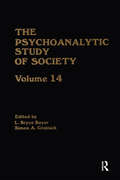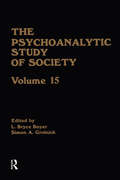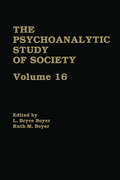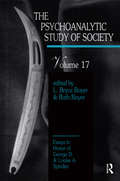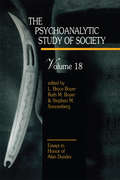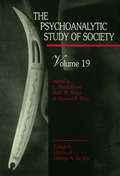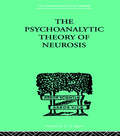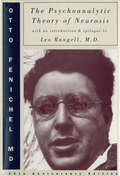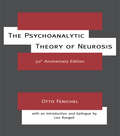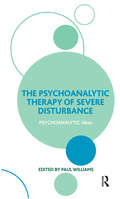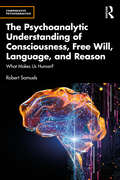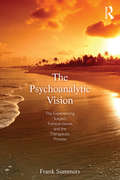- Table View
- List View
The Psychoanalysis of Overcoming Suffering: Flourishing Despite Pain
by Paul MarcusThe Psychoanalysis of Overcoming Suffering: Flourishing Despite Pain offers a guide to understanding and working with a range of everyday causes of suffering from a psychoanalytic perspective. The book delineates some of the underappreciated, everyday facets of the troubling and challenging psychological experiences associated with love, work, faith, mental anguish, old age, and psychotherapeutic caregiving. Examining both the suffering of the patient and therapist, Paul Marcus provides pragmatic insights for changing one’s way of being to make suffering sufferable. Written in a rich but accessible style, one that draws from ancient wisdom and spirituality, The Psychoanalysis of Overcoming Suffering provides an essential guide for psychoanalysts and psychotherapists and their clients, and will also appeal to anyone who is interested in understanding how we suffer, why we suffer and what we can do about it.
The Psychoanalysis of Sexual Functions of Women
by Helene DeutschThis book discusses the problems of the sexual life of woman throughout the duration of her sexual maturity, i.e., from the beginning of puberty onwards. It reports all the new insights into the mental life of woman in her relations to the reproductive function, with the aid of the analytic method.
The Psychoanalysis of the Absurd: Existentialism and Phenomenology in Contemporary Psychoanalysis
by Mark LeffertThe Psychoanalysis of the Absurd offers an interdisciplinary study of Existentialism and Phenomenology and their importance to the clinical work of Contemporary Psychotherapy and Psychoanalysis. The concept of Absurdity, developed by Camus, has never been applied to the therapeutic situation or directly contrasted with its antithesis; the search for personal meaning. The book begins with narrative accounts of the historical development of Psychoanalysis, Existentialism and Phenomenology in 20th century Europe. The focus here is on fin de siècle Vienna and Paris between the Wars as the principal incubators of the two disciplines. Accompanied by composite case illustrations, Leffert then explores his own development of the Psychoanalysis of the Absurd, drawing on the work of Camus, Heidegger and Sartre. Absurdity is first discussed in relation to the Bio-Psycho-Social Self and Dasein is posited as a bridge concept, with personal meaning as the antithesis to Absurdity, before being discussed in relation to the world and how it impinges on self. A final chapter attempts to tie together particular issues raised by the book: Subjective well-being, Meaning, thrownness, Absurdity, Death and Death Anxiety and how we have become technologically enhanced human beings. Existential psychotherapy and psychoanalysis have, until now, largely gone their own way: the goal of this book is to fold them back into Contemporary Psychoanalysis. Establishing that the concept of Absurdity is of singular clinical importance to both diagnosis and therapeutic action, this book will be of great interest to clinicians, philosophers, and interdisciplinary scientists.
The Psychoanalyst and the Child: From the Consultation to Psychoanalytic Treatment (The International Psychoanalytical Association Psychoanalytic Ideas and Applications Series)
by Michel OdyThe Psychoanalyst and the Child explores the unique nature of psychoanalytic work with children. This book is based on more than 30 years of practice and reflection within the framework of the Alfred Binet Centre in Paris, France. The very great diversity of situations encountered at the Centre brings the issue of therapeutic indications to the forefront. Michel Ody focuses on the diversification of fifteen clinical situations and their theorization, ranging from basic consultation to psychoanalytic treatment. With this framework as his starting-point, he looks at the common features between the therapeutic consultation – a consultation that becomes therapeutic – and the analytic treatment, as well as what differentiates them. This implies examining, at the technical level, the different forms of interventions and interpretations presented as well as their metapsychological articulation. Ody draws on decades of clinical expertise to set out not just the basic considerations and problems typically encountered in work with this patient group, but clear guidelines for methodology and technique. Psychoanalysis can be an intellectual process, dependent on the ability of the patient to express themselves verbally, which can make working clinically with children challenging. The Psychoanalyst and the Child seeks to help psychoanalysts through the most challenging of clinical treatments with this patient group.
The Psychoanalyst's Superegos, Ego Ideals and Blind Spots: The Emotional Development of the Clinician (The New Library of Psychoanalysis)
by Vic SedlakPsychotherapists and psychoanalysts enter an emotional relationship when they treat a patient; no matter how experienced they may be, their personalities inform but also limit their ability to recognise and give thought to what happens in the consulting room. The Psychoanalyst’s Superegos, Ego Ideals and Blind Spots investigates the nature of these constrictions on the clinician’s sensitivity. Vic Sedlak examines clinicians’ fear of a superego which threatens to become censorious of themselves or their patient and their need to aspire to standards demanded by their ego ideals. These dynamic forces are considered in relation to treatments which fail, to supervision and to recent innovations in psychoanalytic technique. The difficulty of giving thought to hostility is particularly stressed. Richly illustrated with clinical material, this book will enable practitioners to recognise the unconscious forces which militate against their clinical effectiveness.
The Psychoanalyst, the Theatre of Dreams and the Clinic of Enactment
by R.M.S. CassorlaThis book is recommended to psychoanalysts and therapists interested in the analytical technique, and particularly that work with patients who have deficits in their symbolization capacity. It presents studies of technical aspects of the analytical process with patients who are difficult to reach. Collusions named 'chronic enactments' show that the analytic dyad cannot dream and the analytical field is paralyzed without the analyst perceiving it. Chronic enactments are undone through unconscious acts or behaviours that threaten to destroy the analytical process: behaviours that are named 'acute enactments'. The thorough study of these enactments show that they take the dyad to an awareness of the discrimination between self and object and re-establish the capacity to dream. It is demonstrated that this occurs in an attenuated traumatic form, revealing in the analytical field the externalization of primitive non-dreamed traumas. Clinical, artistic, and mythical models are part of the discussion. The emphasis on clinical aspects allows readers to use different theories to consider the clinical facts. The clinical theories used by the author are mostly post-Kleinian and Bionian.
The Psychoanalytic Ear and the Sociological Eye: Toward an American Independent Tradition
by Nancy ChodorowIn The Psychoanalytic Ear and the Sociological Eye: Toward an American Independent Tradition, Nancy J. Chodorow brings together her two professional identities, psychoanalyst and sociologist, as she also brings together and moves beyond two traditions within American psychoanalysis, naming for the first time an American independent tradition. The book's chapters move inward, toward fine-tuned discussions of the theory and epistemology of the American independent tradition, which Chodorow locates originally in the writings of Erik Erikson and Hans Loewald, and outward toward what Chodorow sees as a missing but necessary connection between psychoanalysis, the social sciences, and the social world. Chodorow suggests that Hans Loewald and Erik Erikson, self-defined ego psychologists, each brings in the intersubjective, attending to the fine-tuned interactions of mother and child, analyst and patient, and individual and social surround. She calls them intersubjective ego psychologists—for Chodorow, the basic theory and clinical epistemology of the American independent tradition. Chodorow describes intrinsic contradictions in psychoanalytic theory and practice that these authors and later American independents address, and she points to similarities between the American and British independent traditions. The American independent tradition, especially through the writings of Erikson, points the analyst and the scholar to individuality and society. Moving back in time, Chodorow suggests that from his earliest writings to his last works, Freud was interested in society and culture, both as these are lived by individuals and as psychoanalysis can help us to understand the fundamental processes that create them. Chodorow advocates for a return to these sociocultural interests for psychoanalysts. At the same time, she rues the lack of attention within the social sciences to the serious study of individuals and individuality and advocates for a field of individuology in the university.
The Psychoanalytic Encounter and the Misuse of Theory
by Lee GrossmanIn clear, accessible language, Lee Grossman addresses the disjuncture between analytic literature and clinical work in an effort to render analytic theorizing more representative of clinical experience. Pointing out the ways in which analytic literature can fail to capture the intensity of feeling and the stumbling, lurching, working in the dark that captures much of clinical engagement, Grossman shows how incomprehensibility is sometimes mistaken for wisdom. As an alternative, Grossman shows how attention to what he calls the syntax of thought can naturally define three different broad categories of life experience: the omnipotence of the neurotic, the wishful, short-sighted thinking of the perverse, and the concrete, disordered thinking of the psychotic. Using rich clinical material, interspersed with detailed exposition and artful satire, Grossman departs from conventional theoretical writing to provide new ways of conceptualising analytic therapy. Addressing analytic therapy as an encounter between two people, both governed by forces about which they know very little, this book provides essential insights for psychoanalysts, psychotherapists and other clinical practitioners both in training and in practice.
The Psychoanalytic Method
by Pfister, OskarFirst Published in 1999. Routledge is an imprint of Taylor & Francis, an informa company.
The Psychoanalytic Study of Society, V. 10
by Werner Muensterberger, L. Bryce Boyer and Simon A. GrolnickFirst published in 1983. Volume 10 of the Psychoanalytic Study of Society papers. with essays on anthropology, religion, history, literature, and music.
The Psychoanalytic Study of Society, V. 11: Essays in Honor of Werner Muensterberger
by L. Bryce Boyer and Simon A. GrolnickVolume 11 includes chapters on the analysis of dybbuk possession and exorcism in Judaism (Y. Bilu); crisis and continuity in the personality of an Apache shaman (L. B. Boyer et al.); culture shock and the inability to mourn ( H. Stein); charismatically led groups (L. Balter); the psychoanalytic and social aspects of telephoning (R. Almansi); and an ethnographic study of hermaphroditism ((G. Herdt & R. Stoller).
The Psychoanalytic Study of Society, V. 12: Essays in Honor of George Devereux
by L. BRYCE BOYER; SIMON A. GROLNICKVolume 12 includes chapters on the hermeneutics of structuralism and psychoanalysis (H. van Velzen); prophetic initiation in Israel and Judah (D. Merkur); the cult phenomenon and the paranoid process (W. Meissner); the ego and adaptation (P. Parin); male adolescent initiation rituals (L. Rosen); gender identity in a New Guinea people (E. Foulks); and the film Cabaret (S. Bauer).
The Psychoanalytic Study of Society, V. 13: Essays in Honor of Weston LaBarre
by L. Bryce Boyer Simon A. GrolnickVolume 13 includes chapters on the contributions of Weston LaBarre (B. Kilbourne); Geza Roheim's theory of myth (S. Morales); the origins of Christianity (W. Meissner); myths in Inuit religion (D. Merkur); the psychology of a Sherpa shaman (R. Paul); the psychoanalytic study of urban legends (M. Carroll); and the dogma of technology (H. Stein & R. Hill).
The Psychoanalytic Study of Society, V. 14: Essays in Honor of Paul Parin
by L. Bryce Boyer Simon A. GrolnickVolume 14 includes chapters on the psychoanalysis of political commitment (P. Parin); Jews and homosexuals as strangers (P. Parin); the analogous tasks of the psychoanalyst and the ethnographer (M. Gehrie); cultic elements in early Christianity (W. Meissner); Jewish apocalyptists (D. Merkur); creationist resistance to evolution (R. Graber & L. McWhorter); sacred objects and transitional phenomena in aboriginal Central Australia; and a review of the contributions of Paul Parin (D. Freeman).
The Psychoanalytic Study of Society, V. 15: Essays in Honor of Melford E. Spiro
by L. Bryce Boyer Simon A. GrolnickVolume 15 features Melford Spiro's "Culture and Human Nature" and "The internalization of Burmese Gender Identity" along with an interview of Spiro by B. Kilbourne and S. Bolle. Additional topics include children's fantasy life in Papua New Guinea (F. Poole); a psychoanthropological approach to Kagwahiv food taboos (W. Kracke); an ethnological and Rorschach study of three groups of Australian aborigines (R. Boyer et al.); a consideration of the "trickster" in relation to issues of sublimation and psychosocial development; and a review of Bettelheim's contribution to anthropology (R. Paul).
The Psychoanalytic Study of Society, V. 16: Essays in Honor of A. Irving Hallowell
by L. Bryce Boyer Ruth M. BoyerVolume 16 offers appreciations of A. Irving Hallowell by M. Spiro, R. Fogelson, and E. Bourguignon. Additional topics include Kagwahiv dream beliefs (W. Kracke); experiences of the self in Papua New Guinea (F. Poole); house design and the self in an African culture (R. & S. LeVine); circumcision and biblical narrative (M. Lansky & B. Kilborne); and cultic elements in early Christianity (W. Meissner).
The Psychoanalytic Study of Society, V. 17: Essays in Honor of George D. and Louise A. Spindler
by L. Bryce Boyer Ruth M. Boyer Stephen M. SonnenbergIn Volume 17, a series of critical appreciations of George and Louise Spindler's multidisciplinary contributions focus on homogeneity and heterogeneity in American cultural anthropology (S. Parman); the molding of American anthropology (M. Suarez); education (H. Trueba); and the uses of projective techniques in the field (R. Edgerton & G. DeVos). Additional topics include the primary process (M. Spiro); psychotherapy and culture (L. Bloom); unconscious aspects of the Arab-Israeli conflict (A. Falk); and medieval messianism and Sabbatianism (W. Meissner).
The Psychoanalytic Study of Society, V. 18: Essays in Honor of Alan Dundes
by L. BRYCE BOYER, RUTH M. BOYER AND STEPHEN M. SONNENBERGOpening with a critical appreciation of Alan Dundes (M. Carroll) and Dundes's own cross-cultural study of the cockfight, Volume 18 includes chapters on psychoanalysis and Hindu sexual fantasies (W. Doniger); the modern folk tale "The Boyfriend's Death" (M. Carroll); a gruesome Eskimo bedtime story (R. Boyer); the homosexual implications of Argentinean soccer (M. Suarez-Orozco); and the symbolism of a Malaysian religious festival (E. Fuller).
The Psychoanalytic Study of Society, V. 19: Essays in Honor of George A. De Vos
by L. Bryce Boyer Ruth M. Boyer Howard F. SteinCritical appreciations of George A. De Vos, a pioneer in the cross-cultural application of projective techniques (M. Suarez-Orozco, P. Lerner), and De Vos's own reminiscences, are followed by contributions true to the spirit of De Vos's methodology. They include a demonstration of the usefulness of projective tests in the psychodiagnostic evaluation of schizophrenia (J. Stone, P. Wilson & B. Boyer); an examination of the role of historical events in the development of Chinese and Japanese personality characteristics (J. Connor); a review of the impact of Freudian and Jungian thought in India (S. Kakar); and a study of loss and grief in a community of the North American Great Plains (H. Stein).
The Psychoanalytic Theory Of Neurosis (International Library Of Psychology Ser.)
by Otto FenichelRoutledge is now re-issuing this prestigious series of 204 volumes originally published between 1910 and 1965. The titles include works by key figures such asC.G. Jung, Sigmund Freud, Jean Piaget, Otto Rank, James Hillman, Erich Fromm, Karen Horney and Susan Isaacs. Each volume is available on its own, as part of a themed mini-set, or as part of a specially-priced 204-volume set. A brochure listing each title in the "International Library of Psychology" series is available upon request.
The Psychoanalytic Theory of Neurosis
by Otto Fenichel Leo RangellA perennially best-selling and influential psychoanalytic work. When Otto Fenichel died suddenly at age 48, Anna Freud mourned the loss of "his inexhaustible knowledge of psychoanalysis and his inimitable way of organizing and presenting his facts." These qualities shine in his classic text, which has been a beacon to generations of psychoanalysts. Investigating the relationship between biological needs and external influences--the tensions and inhibitions that nurture neuroses--Fenichel concludes that "neuroses are social diseases," arising from the demands of civilization on the developing organism. For this 50th anniversary edition, distinguished psychoanalyst Leo Rangell has written an introduction to set the context of Fenichel's work and an epilogue to describe its influence.
The Psychoanalytic Theory of Neurosis (International Library Of Psychology Ser.)
by Otto FenichelThe Psychoanalytic Theory of Neurosis, Fenichel's classic text, summarized the first half century of psychoanalytic investigation into psychopathology and presented a general psychoanalytic theory of neurosis. When Otto Fenichel died, Anna Freud mourned the loss of 'his inexhaustible knowledge of psychoanalysis and his inimitable way of organizing and presenting his facts'. These qualities shine through The Psychoanalytic Theory of Neurosis which has been a standard reference for generations of psychoanalysts. For this anniversary edition, Leo Rangell has written an introduction that sets Fenichel's work in context. He sees Fenichel as a worthy heir to Freud; both men influenced their followers by what Rangell calls 'the charisma of ideas'. In his epilogue, Rangell describes the fate of Fenichel's ideas and of this book as 'a barometer of the place of psychoanalysis ... within the external intellectual world and, even more significantly, of the trends and shifting winds of opinion within the psychoanalytic field itself'. He traces those trends through the turbulent controversies of the field, concluding that Fenichel's observations are as fresh and relevant today as they were fifty years ago.
The Psychoanalytic Therapy of Severe Disturbance (The\psychoanalytic Ideas Ser.)
by Paul WilliamsThis book presents the proceedings of the of the conference on the Psychoanalytic Therapy of Severe Disturbance held in Belfast in June 2008. The aim of the conference was to offer a state of the art communication of the key psychoanalytic thinking and approaches to the conceptualisation and treatment of severe disturbance. The result of a unique gathering of the most eminent psychoanalysts in the field with insights into their work on personality disorder, psychotic states and the nature and function of suicidal ideation.This book will be of interest to mental health professionals - psychiatrists, psychoanalysts, psychotherapists, psychologists, social workers and nurses who have an interest in psychoanalysis and psychotherapy.
The Psychoanalytic Understanding of Consciousness, Free Will, Language, and Reason: What Makes Us Human? (Comparative Psychoanalysis)
by Robert SamuelsThe Psychoanalytic Understanding of Consciousness, Free Will, Language, and Reason examines the ways in which we can use psychoanalysis in order to better understand humanity and explores the question of what makes us human. For thousands of years, thinkers have been trying to define what makes us human. Some of the main questions they have asked is: What is consciousness? Do we have free will? Do animals use language? And what does reason mean? Samuels argues that we need to better understand the psychoanalytic approach to human nature in order to answer these questions, as well as using it to provide a new way of understanding issues such as addiction, political conflict, ideology, and destructive personal relationship. This book will be of vital interest to psychotherapists, as well as students and researchers across the fields of psychoanalysis, philosophy, and psychology.
The Psychoanalytic Vision: The Experiencing Subject, Transcendence, and the Therapeutic Process
by Frank SummersPsychoanalytic therapy is distinguished by its immersion in the world of the experiencing subject. In The Psychoanalytic Vision, Frank Summers argues that analytic therapy and its unique epistemology is a worldview that stands in clear opposition to the hegemonic cultural value system of objectification, quantification, and materialism. The Psychoanalytic Vision situates psychoanalysis as a voice of the rebel, affirming the importance of the subjective in contrast to the culture of objectification. Founded on phenomenological philosophy from which it derives its unique epistemology and ethical grounding, psychoanalytic therapy as a hermeneutic of the experiential world has no role for reified concepts. Consequently, fundamental analytic concepts such as "the unconscious" and "the intrapsychic," are reconceptualized to eliminate reifying elements. The essence of The Psychoanalytic Vision is the freshness of its theoretical and clinical approach as a hermeneutic of the experiential world. Fundamental clinical phenomena, such as dreams, time, and the experience of the other, are reformulated, and these theoretical shifts are illustrated with a variety of vivid case descriptions. The last part of the book is devoted to the surreptitious role beliefs and values of contemporary culture play in many forms of psychopathology. For clinicians, The Psychoanalytic Vision offers a fresh clinical theory based on the consistent application of the subjectification of human experience, and for scholars, a worldview that provides the framework for a potentially fruitful cross-fertilization of ideas with cognate disciplines.
